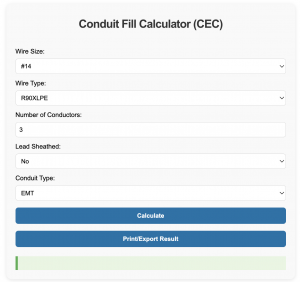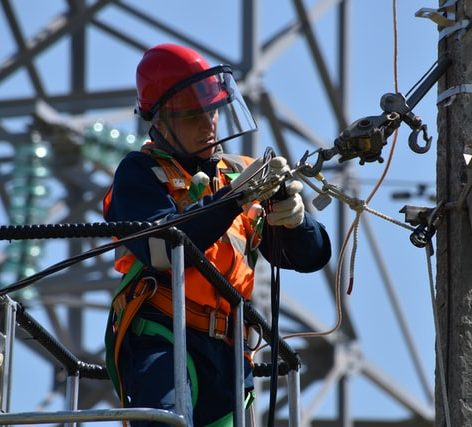An industrial electrician is an individual responsible for the installation, maintenance, and repair of electrical equipment and systems in industrial settings.
They are responsible for all aspects of an electrical system’s safety, performance, and reliability, providing technical support and problem resolution across a wide range of electrical systems.
Some of the duties they will perform include:
- reading and studying building plans, engineering drawings, and field drawings, to determine electrical equipment requirements;
- working with hand tools, power tools, and welding equipment;
- placing new electrical wiring and machinery;
- operate and troubleshoot multiple systems;
In addition they must be able to figure out solutions to electrical problems without damaging existing wiring and clearing any obstructions such as live electric wires.
Industrial electricians typically work in industrial buildings, factories, automotive manufacturing units, and even wind turbines. The extent of the work can vary greatly depending on the specific job and position.
Industrial Electrician Market in Canada

The industrial electrician market in Canada is constantly evolving and the future looks bright! Influenced by a variety of factors, the market is expected to see considerable growth in 2023.
Although an aging population, decreasing birth rates, and stringent immigration policies could all be causing the market to decline, there are exciting opportunities for industrial electricians just around the corner.
Much of the electrician industry’s expansion can be attributed to numerous projects and green initiatives, such as the $4 billion pipeline expansion project in Alberta, and the expansion of the electric car industry across Canada.
Furthermore, automation, artificial intelligence, and robotics are significantly influencing industrial settings and electricians need to stay up-to-date with the latest technology in order to remain competitive.
With the right strategies and outlook, industrial electricians in Canada can look forward to a plentiful and secure career in the years ahead.
How much does an Industrial Electrician make in Canada
The salary of an industrial electrician in Canada will vary depending on education and experience, geographical location, and type of industry. Here are some statistics from the 2019 Ontario Wage Survey:
- Industrial Electricians in Ontario: $25.00 and $30.00 per hour
- Industrial Electricians in Alberta: around $45.00 per hour,
- Industrial Electricians in British Columbia: around 35$ per hour
The Canadian national average salary for industrial electricians is approximately $44,000 per year, however, this can vary depending on experience, education and location. Industrial electricians with an apprenticeship or college diploma will earn a higher wage compared to those without formal education and training.
In addition to an hourly or yearly wage, electricians may receive other benefits such as health benefits and pension plans. Depending on the employer, electricians may also receive additional payment for working overtime, emergency shifts, and hazardous work.
Pros and Cons of being an Industrial Electrician in Canada
Being an industrial electrician in Canada can be a rewarding career. With the right certifications, you can work in a wide range of industries and locations, providing electrical services for businesses, factories, and other organizations. Here are some of the pros of industrial electrician in Canada:
- Job security: Electrical work is always in high demand. Your skills will be desired, and you can always rely on work. Moreover, many industrial organizations are required to regularly maintain and upgrade their electrical systems, creating a regular workflow for industrial electricians.
- Flexible work hours: As an industrial electrician, you can opt to work overtime, during evenings and weekends. This means more favorable work hours and better work-life balance compared to working a full-time 9–5 job.
- Experienced team: Industrial electricians usually work with an experienced team of technicians and engineers, making it easy to learn and grow together.
- Job diversity: Industrial electricians can find work in a variety of industries. From factories and industrial sites to office buildings.
- Variety of technical tasks: Industrial electricians have to perform a variety of tasks, from installation and maintenance to repairs and troubleshooting. This can be quite stimulating as you never know what problems you will be dealing with each day or what solutions you will come up with.
- Opportunity for specialization: Industrial electricians may choose to specialize in a certain field, such as medical equipment or aerospace. As a specialist, you will be able to command higher salaries and gain a larger pool of clients, allowing you to stay on top of your game.
But, if you’re considering becoming an industrial electrician in Canada, there are a number of factors to consider in order to make an informed decision.
On one hand, industrial electricians in Canada can enjoy a steady career offering long-term work prospects and competitive salaries. However, there are also some key cons associated with being an industrial electrician in Canada to be aware of.
Here are the cons of industrial electrician in Canada:
- Day-to-day environment: Working with large, complex electrical systems and machinery can be both physically and mentally draining. Problems with individual components can arise suddenly and Industrial electricians must be prepared and stay perfectly focused in order to deal with both the routine and unexpected work.
- The physical demands: it can also be a hurdle to becoming an industrial electrician in Canada, as industrial electricians often have to work in tight, enclosed spaces which can be cramped and uncomfortable.
- Possibility of injuries: Workplace injuries are not uncommon in the field, making it essential to take all necessary steps for personal safety and to remain aware of your environment at all times.
- Necessity of being always up to date: Given the number of technical skills and knowledge required for industrial electricians in Canada, the job can come with a steep learning curve, meaning most experienced industrial electricians will have to devote a considerable amount of time and effort to keeping up with the latest developments in the field.
- Higher education requirements: Additionally, many companies require at least a college diploma, meaning additional studies and potentially long-term commitments on the career path.
How to become a Industrial Electrician in Canada

Becoming an Industrial Electrician in Canada is a rewarding and complex career path. If you’re interested in becoming a qualified electrician, it’s important to understand the steps and key qualifications required to pursue this profession.
High School Diploma > Post-secondary program or a college of trades >
The educational journey either begins with a high school diploma and one of the following: a post-secondary electrical program in secondary school or the Ontario College of Trades (OCOT).
If you have a high school diploma, attending a post-secondary electrical program will provide you with the training and education necessary to become a qualified industrial electrician.
Depending on the province and jurisdiction, different programs may have different entry requirements and lengths. Generally, these post-secondary electrical programs can last anywhere from six months to two years.
Check on the box below the ministry website from your Province:
Ministries of post-secondary education
- Alberta Innovation and Advanced Education
- British Columbia Ministry of Advanced Education
- Manitoba Advanced Education
- New Brunswick Ministry of Post-Secondary Education, Training and Labour
- Newfoundland and Labrador Department of Advanced Education, Skills and Labour
- Northwest Territories Ministry of Education, Culture and Employment
- Nova Scotia Department of Education
- Nunavut Department of Education
- Ontario Ministry of Advanced Education and Skills Development
- Prince Edward Island Department of Workforce and Advanced Learning
- Quebec – Ministère de l’Éducation et de l’Enseignement supérieur
- Saskatchewan—Ministry of Advanced Education
- Yukon Department of Education
Post-secondary program or a college of trades > Apprenticeship Program >
If you already have an existing post-secondary diploma, you may also be eligible to complete an industrial electrician Apprenticeship Program.
These apprenticeship programs typically involve on-the-job training and coursework in order to acquire the necessary skills, knowledge and experience required to become an effective industrial electrician. They can vary in length, but will usually take four to five years to complete.
Having these qualifications and credentials is an important step to attaining certification.
Apprenticeship Program > Certification
After completing the mandated education and training requirements, electricians must seek licensing through the Red Seal Exam. This involves practical and written examination in order to demonstrate comprehension of the Canadian Electrical Code (CEC) and safety measures prescribed by the certification body.
Once licensed, electricians are allowed to work in Canada.
Being an Industrial Electrician Apprentice in Canada
In Canada, an individual can become an apprentice by completing a pre-apprenticeship program, working with a Registered Training Organization or registering as an apprentice with a provincial or territorial apprenticeship branch. Apprenticeships involve working in the workplace, accompanied by a qualified journeyperson, who provides one-on-one support and guidance.
This relationship is often based on a mentorship model, where apprentices learn the latest techniques and practices while gaining valuable career experience. While working, they can apply theory to practical problems by testing, inspecting and measuring products, troubleshooting electrical systems, and making repairs.
Apprentices must also remain compliant with provincial standards and regulations. Long hours may be involved as well, and the apprentice is subject to work in different environments, such as industrial settings, warehouses and offices.
How to get the Industrial Electrician Red Seal Certificate in Canada

In Canada, individuals interested in pursuing a career in industrial electrician can gain the Red Seal certification, recognized nationwide. This certification indicates they have attained a professional level of training suitable for employers and will be able to practice in all provinces and territories across Canada.
First, individuals must find an accredited training program to become an electrician in their province. Next, individuals must work and gain on-the-job experience in electrician and related trade. They should seek out training programs or employers that offer not only experience but also support and mentorship.
This will help them build the necessary skills and knowledge to obtain an Electrician Certificate of Qualification in their province or territory. With the completion of the apprenticeship and passing the provincial or territorial qualifications and exams, they can apply for the Red Seal certification at your provincial or territorial apprenticeship and certification office .
Once they have applied for the Red Seal, they must pass a theoretical and practical exam. The practical exam is conducted in laboratories, apprenticeship offices, and other approved places.
After this, they must be able to self-evaluate their skills and knowledge. For the Red Seal Program, self-evaluation is part of the qualification process. The program also requires portfolios of previous work, training and experiences for people to gain the industrial electrician technician certification.
What does 442a mean in Canada’s Red Seal Exam
The 442A certification on the Canadian Red Seal exam is a designation for individuals who work in the Industrial Electrician trade.
The 442A designation indicates that an individual has successfully passed the Red Seal exam in the Industrial Electrician trade and has met the standards set by the program.
This certification is highly valued by employers in the industry, and it is often a requirement for many job opportunities. Holding a 442A certification can also lead to higher pay and greater job mobility for the trade’s workers.
What is Red Seal Occupational Standards for Industrial Electrician
The Red Seal Occupational Standards (RSOS) for Industrial Electricians are a set of skills required to gain recognition as a certified tradesperson in any of the provinces and territories that participate in the Program.
The standards, which are established by the Canadian Council of Directors of Apprenticeship (CCDA), outline the duties, tasks, and responsibilities of the trade, as well as the knowledge and experience required from each individual attempting to become certified.
The Red Seal Industrial Electrician standards represent the universal set of performance requirements for the trade. This includes common core and essential workplace knowledge, in addition to standardized mathematical, oral communication and problem-solving abilities.
Occupational Standard for current exams
For those looking to become a Red Seal Industrial Electrician, the occupational standard that must be met is set by the National Occupational Analysis (NOA).
The NOA is a document that covers all the necessary skills, knowledge, and abilities that are most commonly related to the trade, which must be possessed by those wishing to obtain their Red Seal certification, and you can download it on the link above.
The NOA is meant to help ensure that each candidate has the capacity to perform their job functions no matter where they go, and while the same core competencies must be fulfilled, specific duties and levels of integrative knowledge may vary depending on the region and jurisdiction.
In order to be considered for the exam, a minimum of 4,500 hours experience in the trade must be met. These will have to have been within the past five years prior to their application, or since the completion of a three- or four-year apprenticeship program.
In circumstances where experience or an apprenticeship is lacking, the candidate may be considered if they have completed four years of post-secondary education related to the trade.
The exam itself consists of multiple-choice questions, as well as questions involving troubleshooting scenarios and drawings. It’s a thorough assessment of the candidate’s abilities, designed to ensure only the most qualified individuals become certified Red Seal Industrial Electricians.
The exam must be completed with a minimum score of 70% for successful certification. This is then followed by an oral or practical exam, which varies depending on the region.
For those who have the knowledge and expertise necessary to be a successful Red Seal Industrial Electrician, but require further understanding of the regulations and policies in their region, additional courses or workshops may be necessary prior to taking the exam.
Essential Skills
The Canadian Red Seal program aims to recognize the skills and knowledge of tradespeople across the country, and the Essential Skills required for trades covered by the program vary depending on the trade.
Here are some of the “basic” skills, that are required on most trades, and some Industrial Electrician Essential Skills:
- Reading and writing: The ability to understand and interpret technical information, such as schematics, blueprints, and technical manuals.
- Numeracy: The ability to perform calculations and use mathematical concepts, such as measuring and estimating.
- Problem-solving: The ability to analyze information, identify problems, and develop solutions.
- Communication: The ability to clearly and effectively communicate information, both verbally and in writing.
- Working with others: The ability to work effectively with a team and to coordinate work activities with other tradespeople.
- Continuous learning: The ability to continuously learn new techniques, technologies, and regulations in the trade.
In addition to these Essential Skills, tradespeople must also have a strong understanding of the specific techniques, technologies, and regulations related to their trade.
Some more specific Industrial Electrician Skills are:
- Comprehensive knowledge of the Canadian Electrical Code (CEC) and its regulations. This knowledge must be applied practically and include its rules for the design, installation and maintenance of electrical systems;
- Be knowledgeable of safety regulations, as it pertains to operating and maintaining electrical equipment, to ensure the protection of workers, assets, and the public;
- Be well-versed in electrical formulas and concepts to effectively solve problems related to electrical systems. This includes understanding and correctly interpreting documents, such as blueprints, diagrams, and wiring specifications, to diagnose and resolve any electrical related issues that may arise. As well, recognizing and utilizing the proper cables, connectors and fixtures for any given situation is necessary for proper system installation and data transfer.
How to Prepare for the Red Seal Industrial Electrician Exam

The Red Seal Industrial Electrician Exam is an arduous process, so preparation is extremely important. Below are some steps you can take to ensure you perform at your highest ability level.
Understand the Exam Structure
Before you start studying for the Industrial Electrician exam, it’s important to understand what the exam will include and how it will be scored.
The exam consists of two parts—a practical evaluation and a multiple-choice survey.
- During the practical evaluation, you will demonstrate your skills and knowledge in a variety of hands-on tasks that relate to industrial electrical installations, troubleshooting and maintenance.
- The multiple-choice survey will focus on your theoretical knowledge. By understanding the structure of the exam, you can target your preparation to ensure that you’re ready to perform your best when the time comes.
Learn the Exam Content
The Red Seal Industrial Electrician program divides the content for the exam into several categories, which includes:
- Electrical Systems;
- Circuit Breakers;
- Conduit Bending;
- Relays;
- Motors;
- Wiring Practices;
- Transformers;
- Basic Electricity and Safety Information;
- Industrial Building Systems;
- Power Distribution.
Make sure that you take the time to brush up on your knowledge in all of these categories by signing up with our Gold Industrial Electrician Membership.
With this membership you have Lifetime Access to up to date with the new 2021 Code:
- Study Guides on: Common Occupational Skills, Power Distribution And Generating Systems, Electrical Equipment, Emergency And Standby Systems, Communication Systems, Process Control Systems, Building And Environmental Control System;
- 1000+ Exam Practice Questions
- Bonus Quizzes
- Practice Exam Simulator
Take Practice Exams
Practicing the actual questions that you’ll be expected to answer during the exam is a great way to prepare. There are numerous resources available that provide practice questions, which can be used to gauge your current level of competence in various categories.
With practice exams, you’ll become familiar with the format and build your confidence. Plus, your results will indicate which areas you need to improve on.
If you are confident in your knowledge of the trade and only want to practice for the exam, sign up for our Silver Industrial Electrician Membership.
With this membership you have Lifetime Access to up to date with the new 2021 Code:
- Free Communication Systems Study Module
- 1000+ Exam Practice Questions
- Bonus Quizzes
- Practice Exam Simulator
Examples of Red Seal Industrial Electrician exam questions:
- What are the safety regulations when installing a new fuse box to a residential building?
- How would you troubleshoot a wiring issue on an industrial motor reversing system?
- What precautionary methods should be taken before beginning any electrical maintenance or repair on a high voltage circuit?
- What type of electrical circuit is characterized by having a single pathway for current flow?
- Series Circuit
- Parallel Circuit
- Combined Circuit
- Which of the following is not a type of electrical conductor?
- Copper
- Aluminum
- Glass
- What is the formula for calculating electrical power?
- P = IV
- P = I^2R
- P = V^2/R
Utilize Various Resources
There are a multitude of Red Seal Industrial Electrician exam guides and practice exams available in both print and electronic formats, so take the time to explore the different sources.
Utilize the existing materials to gain a more comprehensive knowledge of the subject. Moreover, don’t be afraid to reach out for help. Professional industrial electricians, mentors, colleagues and instructors can provide you with insight into the industry and offer advice as to how you can go about preparing for the exam.
How to validate your industrial Electrician Certificate in Canada
Getting certified as an industrial electrician in Canada can be a complicated process but is an important step for anyone looking to work in the electrical field.
First, applicants must contact the relevant provincial Ministry of Labour to make sure their qualifications meet provincial standards. In some provinces, this may also include additional coursework or examinations.
Applicants should also make sure to have on hand any relevant certificates, diplomas, and/or degrees, with proof of experience in the electrical field also required if they don’t have the necessary qualifications.
Once that’s done, the next step is to pass the written and practical examinations specific to the province. These cover areas such as safety protocols, electrical theory, and wiring diagrams.
Successful applicants then need to apply for a registration number that allows them to work as certified electricians, typically by submitting proof of the completed examinations and documents.
It’s essential that applicants keep a copy of their registration number and qualifications handy as they’ll need to present these at job sites.
Ultimately, following the steps to validation can be time-consuming but is a crucial part of achieving industrial electrician certification in Canada.




